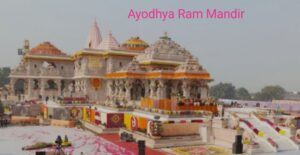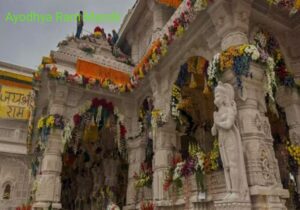The Ayodhya Ram Mandir is not just a religious structure; it symbolizes a deep historical and cultural connection for Hindus around the world. The temple’s significance is intertwined with ancient religious texts and has been at the center of one of the most contentious legal and political debates in modern Indian history. For over a century, the site has been a source of conflict, culminating in a historic Supreme Court verdict in 2019 that paved the way for the temple’s construction. In this blog post, we will explore the historical background, legal battles, and current developments surrounding the Ram Mandir in Ayodhya.

1: The Historical Background of Ayodhya Ram Mandir
1. Ayodhya in Indian Mythology
Ayodhya is regarded as one of the seven most sacred cities for Hindus. According to Hindu mythology, it is the birthplace of Lord Ram, an avatar of Vishnu, and the central figure of the ancient Indian epic, the Ramayana. Ayodhya’s connection to Lord Ram makes it a revered site for Hindus worldwide. In the Ramayana, Ayodhya is described as a prosperous and peaceful city, ruled by King Dasharatha, the father of Lord Ram. The belief that Ayodhya was the home of Lord Ram has made the city a site of pilgrimage for centuries, holding immense spiritual significance for followers of the Hindu faith.
2. Ayodhya’s Significance in Indian History
Ayodhya’s historical importance extends beyond its religious significance. As a part of ancient India, the city was ruled by powerful dynasties such as the Guptas and Mauryas, who contributed to the spread of Hindu culture and religion. Throughout history, temples dedicated to various Hindu deities, including Lord Ram, have been built and renovated in the city. Ayodhya has also been an important cultural and religious hub for Buddhism and Jainism. Its strategic location on the Sarayu River made it a center for trade and culture during ancient times.
2: The Ayodhya Ram Mandir Dispute
1. The Origin of the Dispute
The roots of the Ayodhya dispute date back several centuries, but the modern conflict began in the 19th century when tensions arose between Hindus and Muslims over the site of the Babri Masjid. Many Hindus believe that the mosque, constructed in 1528 by Mughal Emperor Babur, was built on the ruins of a Hindu temple that marked the birthplace of Lord Ram. This belief, coupled with historical grievances, led to a long-standing dispute over the ownership of the land. The claims were based on historical accounts, religious texts, and archaeological findings, which purportedly showed evidence of a pre-existing temple beneath the mosque.
2. Legal Battles Over the Site
The legal battle over the disputed site has spanned over 150 years. The first formal legal case was filed in 1885 when a Hindu priest sought permission to build a temple on the site. The British colonial courts dismissed the claim, but the issue remained unresolved. Over the years, multiple lawsuits were filed by both Hindu and Muslim parties, each seeking control over the site. The most significant development came in 1949 when idols of Ram Lalla (infant Lord Ram) were placed inside the mosque, leading to further communal tensions. The site was sealed, and a series of court battles ensued, with each side presenting historical, archaeological, and religious arguments to support their claims.
3. Babri Masjid Demolition in 1992
One of the most pivotal events in the Ayodhya dispute was the demolition of the Babri Masjid on December 6, 1992. A large group of Hindu activists, who believed the mosque was built over the birthplace of Lord Ram, demolished the structure, despite the presence of law enforcement. The demolition sparked widespread communal riots across India, resulting in the deaths of thousands and leaving a lasting scar on the country’s social fabric. The event remains a point of contention in India’s history, shaping the political and religious discourse for decades.
3: The Supreme Court Verdict (2019)
1. Key Points of the Supreme Court Judgement
In November 2019, after decades of legal wrangling, the Supreme Court of India delivered a landmark verdict. The court ruled in favor of the Hindu claimants, awarding the disputed land for the construction of a Ram temple. The judgment was based on historical records, archaeological evidence, and religious sentiment, but the court also took steps to ensure communal harmony by allocating five acres of land at an alternate location in Ayodhya for the construction of a mosque. The unanimous decision was seen as an effort to balance religious rights while resolving a long-standing dispute.
2. Impact of the Verdict
The Supreme Court’s verdict was met with mixed reactions. For many Hindus, it was a moment of triumph, as the construction of the Ram Mandir had been a key demand for decades. However, some sections of the Muslim community expressed disappointment with the decision, although the allocation of alternative land for a mosque was seen as a step toward reconciliation. The judgment was largely accepted peacefully, with both religious communities pledging to maintain harmony. International reactions were largely supportive, with many recognizing the court’s attempt to balance religious rights and maintain peace.

4: The Construction of the Ram Mandir
1. Laying of the Foundation Stone
On August 5, 2020, Prime Minister Narendra Modi laid the foundation stone for the Ram Mandir in a grand ceremony that was broadcast across the nation. The event was attended by key religious leaders, government officials, and dignitaries. The laying of the foundation stone marked a new chapter in the long history of the Ayodhya site, symbolizing the culmination of decades of struggle for the Hindu community.
2. Architecture and Design of the Temple
The design of the Ram Mandir is a blend of traditional Indian temple architecture and modern construction techniques. The temple is being constructed in the Nagara style of architecture, typical of North Indian temples, and will feature intricate carvings, massive pillars, and towering spires. The temple complex will also include a museum and a large public plaza for devotees. The final structure is expected to be over 50 meters tall and cover an area of approximately 57,000 square feet, making it one of the largest Hindu temples in the world.
3. Progress of Construction
As of 2024, significant progress has been made in the construction of the Ram Mandir. The temple’s foundation and lower floors are nearing completion, and the structure is expected to be ready for worship by 2025. The construction is being funded through donations from millions of Hindus across India and abroad, reflecting the deep emotional and religious connection that the community has with the temple. Regular updates on the construction progress are provided by the Ram Janmabhoomi Trust, the body overseeing the project.
5: Cultural and Religious Impact
1. Significance for the Hindu Community
The construction of the Ram Mandir holds immense significance for Hindus worldwide. For many, it represents the fulfillment of a centuries-old dream and is seen as a symbol of faith and resilience. The temple is expected to become a major center for religious activities, with millions of pilgrims expected to visit the site annually. The Ram Mandir is not just a place of worship; it is a symbol of the cultural and spiritual identity of Hindus.
2. Ayodhya as a Religious Tourism Hub
With the construction of the Ram Mandir, Ayodhya is set to become one of the most important pilgrimage destinations in India. The city is already witnessing a surge in religious tourism, with the government and private developers investing heavily in infrastructure to accommodate the influx of devotees. Hotels, roads, and transportation services are being upgraded to ensure a smooth experience for visitors. The temple is expected to provide a significant boost to the local economy, creating jobs and business opportunities for the people of Ayodhya.
3. Ram Mandir and the Global Hindu Diaspora
The Ram Mandir also holds significance for the global Hindu diaspora. Many Hindus living outside India have contributed financially to the temple’s construction, and the temple is seen as a symbol of cultural unity for Hindus worldwide. The global Hindu community has closely followed the developments in Ayodhya, and the temple’s construction is expected to foster a stronger sense of cultural pride and religious identity among Hindus across the world.
6: Political and Social Ramifications
1. Ram Mandir and Indian Politics
The Ram Mandir has been a central issue in Indian politics, particularly for the Bharatiya Janata Party (BJP), which has long advocated for the construction of the temple. The issue has played a significant role in shaping electoral outcomes, especially in northern India. The BJP’s commitment to the Ram Mandir issue has garnered it significant support from Hindu voters, and the party has used the temple’s construction as a symbol of its commitment to Hindu nationalism.
2. Ayodhya Verdict’s Impact on Communal Relations
While the Supreme Court verdict was largely accepted peacefully, the Ayodhya dispute has left a deep impact on communal relations in India. Efforts have been made by the government and civil society to maintain harmony between Hindus and Muslims in the wake of the judgment. Initiatives promoting dialogue and understanding between the two communities have been crucial in preventing further communal tensions.
3. Future Implications for Secularism in India
The resolution of the Ayodhya dispute and the construction of the Ram Mandir raise important questions about the future of secularism in India. While the court’s judgment was seen as a balanced attempt to resolve the conflict, the temple’s construction is likely to influence India’s political and social landscape in the years to come. The challenge for India will be to ensure that its secular fabric remains intact while respecting the religious sentiments of all its communities.
As India moves forward, it will need to balance its commitment to secularism with the growing influence of religious identity in the public sphere. The Ayodhya dispute has shown that religious sentiments can have a significant impact on national politics, but it has also highlighted the importance of legal and democratic processes in resolving such issues. The government, political parties, and civil society must work together to ensure that future religious disputes are handled with sensitivity and respect for all communities, preserving India’s rich tradition of cultural and religious diversity.
Conclusion:
The Ayodhya Ram Mandir stands as a testament to India’s ability to navigate complex historical and religious challenges through democratic and legal means. As the temple rises, it will not only honor the legacy of Lord Ram but also symbolize the enduring strength of India’s diverse cultural fabric. The temple’s completion is eagerly awaited, not just by devotees, but by a nation that hopes to move beyond the conflicts of the past and embrace a future of unity, peace, and shared cultural heritage.
FAQs:
1.How long does Darshan take in Ayodhya?
2.What is the real name of Ayodhya?
3.Is there any ticket for Ayodhya Ram Mandir?
4.How long did it take to build the Ram temple?
5.Ayodhya Ram Mandir Photo
6.Ayodhya Ram Mandir distance
7.Ram Temple
8.Shri Ram Janmabhoomi Teerth Kshetra
9.Ayodhya Ram Mandir Darshan Booking 2024
10.Ayodhya Ram Mandir Timing
11.Ayodhya Ram Mandir History
12.Ayodhya Ram Mandir opening
13.Ayodhya Ram Mandir Which state
14.Ayodhya Ram Mandir Ticket Price
15.Ayodhya Ram Mandir current status
16.Ayodhya ram mandir distance from my location

